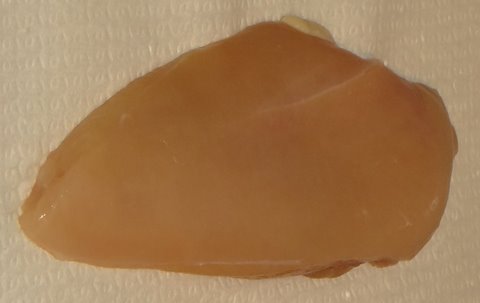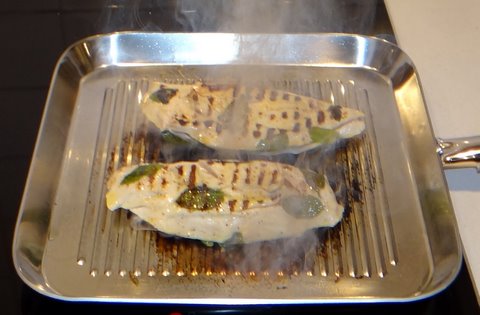Believe it or not, but after experimenting with sous-vide cooking for over a year now, I’ve just tried chicken breast sous-vide for the frist time! This is because I usually stick to chicken thighs, which have more flavor and are juicier and when properly cooked are just as tender as chicken breast. But after some raves about chicken breast sous-vide I thought I’d give it a try. The verdict: I still prefer chicken thighs, but the chicken breast sous-vide wasn’t bad at all!
Whenever you eat chicken, make sure to invest in at least some quality. You don’t want chicken that has been injected with water etc. This chicken breast was organic.
I seasoned the chicken breast with salt and freshly ground black pepper and sealed it with a drop of olive oil, some basil leaves and some very thin slices of lemon. Then I cooked it sous-vide for 45 minutes at 60C/140F. This time and temperature is enough to pasteurize the meat throughout, so there is no worry about food safety. This chicken breast was only 2 cm thick. For a thicker chicken breast, more time will be needed to pasteurize. You can look up the time here.
When cooking sous-vide, always use less flavorings (in this case lemon and basil) than you would normally do, because the sous-vide method will amplify the taste. You could also sprinkle a tiny bit of garlic powder on the chicken in this recipe if you like.
Then I rubbed the breast with olive oil and did a quick sear on a very hot griddle.
The chicken breast was very tender and juicy, with a nice texture that’s different from grilled chicken breast.






Is this something I can store and bring to work everyday? I like to do all of my lunch cooking on Sunday and reheat the same meal. Most chicken meals get kind of dry though
LikeLike
This depends on how you are planning to reheat it. Microwave? It may also be tricky to cook this on Sunday and store it until Friday, unless your refrigerator is very cold (modern fridges have 0C/32F compartments in which you can keep food much longer).
What you could also do is sear before sous-vide, cook sous-vide as indicated, rapidly cool the pouch with chicken in ice water and store until needed (this is ok for a few days and longer if your fridge is cold enough). Then reheat when you want to eat by dropping the pouch into a container with 60C/140F water and leaving it in for 10 minutes or so. The water may be a bit warmer than that to start since you will drop something cold in, but not too hot because then you will take away the juicyness.
I could provide a more detailed answer if you tell me more about the reheating and storage options you have.
LikeLike
To pasturize chicken at 60 degrees in 45 minutes, it would have to be 5mm thin. A normal chicken breast like the ones in your pictures will be about 3cm thick and takes about 2 hours to pasteurize at 60 degrees. You can check out Douglas Baldwin’s excellent web site for the numbers (and the sources for the numbers): http://douglasbaldwin.com/sous-vide.html#Table_4.1
You are actually endangering people’s health with your incorrect statements above. When taking your first steps in sous vide cooking, you have to understand that thickness of the food is an extremely important factor in determining cooking times.
LikeLike
Hi Frank,
I am fully aware that thickness is what determines cooking times in sous-vide cooking, which you could have noticed in multiple posts on my blog.
Your statement of endangering people’s health is out of line. Douglas Baldwin’s table is overly conservative.
The best textbook out there about sous-vide is Modernist Cuisine by Nathan Myhrvold et al. The cooking times listed in Modernist Cuisine are backed by FDA standards as well as scientific research.
According to the simplified poulty breast table on page 193 of volume 1, chicken breast requires 19 minutes and 30 seconds to be pasteurized at 60C/140F, regardless of the thickness.
On the same page, the 6.5D salmonella reduction time is listed as 11 minutes and 34 seconds. This means that the center should first reach the temperature of 60C/140F and then be held at that temperature for a further 11’34” to be pasteurized.
The time for the center to reach 60C/140F (from 5C/40F) is 34 minutes and 31 seconds if the chicken is 2.5 cm thick (MC Vol 2, page 279). So together this adds up to 45 minutes as per my post. This is a conservative estimate compared to the 19’30” listed in the simplified table.
Chicken breast here is never thicker than 2.5 cm, but usually thinner.
A chicken breast of 5 mm thick would be pasteurized to 6.5D after 13 minutes, not 2 hours! (1m23s + 11m34s). I think Douglas Baldwin’s table is so conservative because he used some (very) conservative assumptions and approximations.
No hard feelings.
Stefan
LikeLike
I think Frank should have replied. He was pretty out there with the accusations.
Nice chicken BTW.
Best,
C
LikeLiked by 1 person
Hi Stefan! Love your website! 🙂 i got my immersion circulator a few days ago and the first thing i attempted to cook was a chicken breast. I put butter and herbs in the bag (no salt until after it was cooked) and put it in the waterbath pre heated at 60 degrees for an hour. Then i seared it for no longer than half a minute on each side. It came out dry like a usual overcooked chicken breast (The piece was rather small). I can’t figure out what i did wrong as all the guidance i could find had about the same time and temperature.. Your input would be great!!
LikeLike
Hi Amalia,
If it is a small piece, you should allow it to cool off a bit before searing it. Otherwise, even half a minute on each side is enough to overcook it.
Also, it is of course important to use good quality chicken, preferably not frozen.
Try again and let me know what happens.
60 degrees at 1 hour is fine.
LikeLike